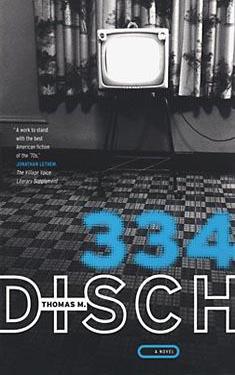Thomas Disch
Completed 3/27/2016, reviewed 3/28/2016
3 stars
This is the first time I read a book where I thought the
prose was great but the story was hard to follow. Based on this one book, I feel Thomas Disch
is one of the best writers I’ve read in a while. Unfortunately, the structure of the book is
what threw me into general disarray. The
book is actually a collection of interrelated short stories about people,
particularly the members of one family, who live in the population controlled
near future in subsidized housing with the numeric address of 334. It’s faintly reminiscent of the
interrelatedness of J.D. Salinger’s Wise Child stories (“Franny and Zooey”,
“Seymour”, “Raise High the Roof Beam, Carpenters”, etc).
 The first half of the book is composed of actual short
stories. They are fairly easy to
follow. My favorite was the first story,
about a young man madly in love with a young woman who finds out he doesn’t
score high enough in his life analysis to qualify for having children. It sets the mood for the
government-controlled near future that the rest of the stories take place
in. The story also gives us a sample of
one aspect of the future which is positive.
Same-sex and interracial relationships are normal and unremarkable. But in general, many of the sexual
relationships, as well as interpersonal relationships are dysfunctional, if not
downright depraved. And racism still
abounds despite the normalization of the relationships.
The first half of the book is composed of actual short
stories. They are fairly easy to
follow. My favorite was the first story,
about a young man madly in love with a young woman who finds out he doesn’t
score high enough in his life analysis to qualify for having children. It sets the mood for the
government-controlled near future that the rest of the stories take place
in. The story also gives us a sample of
one aspect of the future which is positive.
Same-sex and interracial relationships are normal and unremarkable. But in general, many of the sexual
relationships, as well as interpersonal relationships are dysfunctional, if not
downright depraved. And racism still
abounds despite the normalization of the relationships.
The last part of the book is entitled 334 and follows the
lives of several members of one of the families in the building. It was very confusing to me despite the fact
that I did a little research on the book before reading it. It follows Mrs. Hanson and two of her
daughters over seven years. The chapters
are arranged so that you bounce back and forth in the time line and it’s
difficult to tell if it’s fantasy or reality.
Looking at it from the outside and contemplating the structure, it’s
pretty brilliant, but the reading of it is not pleasant experience. This is where the conflict arose for me
between the prose and the form. Disch
provides a graph to help you navigate through the stories, but I still found it
very difficult to figure out what was going on.
Simultaneously, reading the prose was still enjoyable. I just couldn’t piece it all together.
I should give a warning that some of the stories in this
book pretty depraved. There’s one story
about a morgue worker who sells the hospital’s unclaimed dead to a necrophiliac
agency. There’s also a story about a
group of pre-teens who plan a murder. On
a less depraved but just as strange note, there’s a story about a couple whose
life is meaningless without children, but it’s the husband who needs to have
the maternal experience.
There’s a lot going on in this book and the best thing about
it is that it’s well-written. It’s just
not the most pleasant book to read from the content and form perspectives. This is a book I’d like to read again at some
point, to see if I understand it better.
So from my initial experience, I can only give this book three stars out
of five.
No comments:
Post a Comment